Over the past 200+ years there have been five naval ships named the Yorktown,
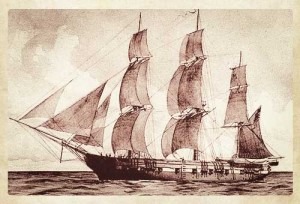 The first USS Yorktown was a 16-gun sloop-of-war of the United States Navy. Authorized to be constructed by the Congressional Act of 3 April 1837, five ‘Third Class Sloops’ included the Princeton, Yorktown, Dale, Preble, Marion, and Decatur. Yorktown’s hull was laid down in 1838 by the Norfolk Navy Yard, launched on 17 June 1839, and she was commissioned on 15 November 1840. Used mostly for patrolling in the Pacific and anti-slave trade duties in African waters, the vessel was wrecked in 1850. In 1999, the Portuguese company Arqueonautas Worldwide S.A. recovered various articles from the wreck of the Yorktown, which were subsequently auctioned at Sothebys in London. In early 2001, the U.S. Department of Justice informed Sothebys that under United States law (principally the National Historic Preservation Act of 1966, and subsequently the 2005 Sunken Military Craft Act) all wrecks of ships and aircraft remain the property of the U.S. Government. Sothebys returned the objects; which included cutlery, coins, sword hilts and scabbards, a powder flask, and various ship fittings.
The first USS Yorktown was a 16-gun sloop-of-war of the United States Navy. Authorized to be constructed by the Congressional Act of 3 April 1837, five ‘Third Class Sloops’ included the Princeton, Yorktown, Dale, Preble, Marion, and Decatur. Yorktown’s hull was laid down in 1838 by the Norfolk Navy Yard, launched on 17 June 1839, and she was commissioned on 15 November 1840. Used mostly for patrolling in the Pacific and anti-slave trade duties in African waters, the vessel was wrecked in 1850. In 1999, the Portuguese company Arqueonautas Worldwide S.A. recovered various articles from the wreck of the Yorktown, which were subsequently auctioned at Sothebys in London. In early 2001, the U.S. Department of Justice informed Sothebys that under United States law (principally the National Historic Preservation Act of 1966, and subsequently the 2005 Sunken Military Craft Act) all wrecks of ships and aircraft remain the property of the U.S. Government. Sothebys returned the objects; which included cutlery, coins, sword hilts and scabbards, a powder flask, and various ship fittings.
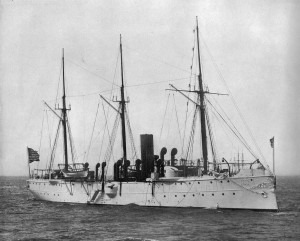 The second USS Yorktown (Gunboat No. 1/PG-1) was lead ship of her class of steel-hulled, twin-screw gunboats in the United States Navy in the late 19th and early 20th centuries. She was the second U.S. Navy ship named in honor of the American Revolutionary War’s Battle of Yorktown. Yorktown was laid down in May 1887 and launched in April 1888. She was just over 244 feet (74 m) long and 36 feet (11 m) abeam, and displaced 1,710 long tons (1,740 t). She was equipped with two steam engines which were supplemented with three schooner-rigged masts. The ship’s main battery consisted of six 6-inch (15.2 cm) guns and was augmented by an assortment of smaller-caliber guns. After three years out of commission from 1903 to 1906, Yorktown hosted the Secretary of the Navy on board when he greeted the Great White Fleet on its arrival in San Francisco in May 1908. Over the next five years, most of Yorktown ’s time was spent in sealing patrols in Alaska and duty in Latin American ports. From July 1912, Yorktown was out of commission for alterations, but resumed duties off the Mexican, Nicaraguan, and Honduran coasts beginning in April 1913. Through World War I, Yorktown continued in the same role, until she departed for the East Coast of the United States in April 1918. She served an escort for one convoy headed to Halifax in August, and remained in coastal escort duties in the east until January 1919. After arrival at San Diego in February, she was decommissioned for the final time in June 1919.
The second USS Yorktown (Gunboat No. 1/PG-1) was lead ship of her class of steel-hulled, twin-screw gunboats in the United States Navy in the late 19th and early 20th centuries. She was the second U.S. Navy ship named in honor of the American Revolutionary War’s Battle of Yorktown. Yorktown was laid down in May 1887 and launched in April 1888. She was just over 244 feet (74 m) long and 36 feet (11 m) abeam, and displaced 1,710 long tons (1,740 t). She was equipped with two steam engines which were supplemented with three schooner-rigged masts. The ship’s main battery consisted of six 6-inch (15.2 cm) guns and was augmented by an assortment of smaller-caliber guns. After three years out of commission from 1903 to 1906, Yorktown hosted the Secretary of the Navy on board when he greeted the Great White Fleet on its arrival in San Francisco in May 1908. Over the next five years, most of Yorktown ’s time was spent in sealing patrols in Alaska and duty in Latin American ports. From July 1912, Yorktown was out of commission for alterations, but resumed duties off the Mexican, Nicaraguan, and Honduran coasts beginning in April 1913. Through World War I, Yorktown continued in the same role, until she departed for the East Coast of the United States in April 1918. She served an escort for one convoy headed to Halifax in August, and remained in coastal escort duties in the east until January 1919. After arrival at San Diego in February, she was decommissioned for the final time in June 1919.
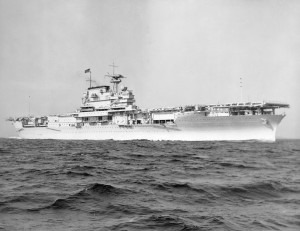 The third USS Yorktown (CV5) was laid down at the Newport News Shipbuilding & Drydock Company on May 21, 1934, USS Yorktown was the lead ship of its class and the first large purpose-built aircraft carrier constructed for the US Navy. Sponsored by First Lady Eleanor Roosevelt, the carrier entered the water nearly two years later on April 4, 1936. Work on Yorktown was completed the following year and the vessel was commissioned at the nearby Norfolk Operating Base on September 20, 1937. Departing the Chesapeake in January 1938, Yorktown steamed south to conduct its shakedown cruise in the Caribbean off Puerto Rico, Haiti, Cuba, and Panama. Yorktown received orders to join the Pacific Fleet at San Diego, CA in April 1939. With World War II already raging in Europe and the Battle of the Atlantic underway, Yorktown was ordered back to the Atlantic Fleet in April 1941. Taking part in neutrality patrols, the carrier patrolled between Newfoundland and Bermuda to prevent attacks by German u-boats. After completing one of these patrols, Yorktown put into Norfolk on December 2. While in port, the carrier’s crew learned of the Japanese attack on Pearl Harbor five days later and sailed for the Pacific in late December later. In the Pacific, Yorktown completed numerous resupply and escort missions, as well as to ship-to-ship engagements. As the lead ship for Task Force (TF17) Yorktown escorted a convoy of Marines to reinforce American Samoa. Completing this task, it united with TF8 (USS Enterprise) for strikes against the Marshall and Gilbert Islands. In February, TF17 sailed to the Coral Sea to operate in conjunction with TF11 (USS Lexington). Yorktown remained in the Coral Sea until April when it withdrew to Tonga to resupply. It rejoined Lexington after Pacific Fleet Commander Nimitz obtained intelligence about a Japanese advance against Port Moresby. Entering the area, Yorktown and Lexington took part in the Battle of the Coral Sea on May 4-8. In the course of the fighting, American aircraft sank the light carrier Shoho and badly damaged the carrier Shokaku. In exchange, Lexington was lost after being hit by a mix of bombs and torpedoes. Yorktown‘s skipper evaded eight Japanese torpedoes but saw his ship take a severe bomb hit. Returning to Pearl Harbor, it was estimated that it would take three months to fully repair the damage. Nimitz directed only emergency repairs be made and Yorktown return to sea as quickly as possible. As a result, Yorktown departed Pearl Harbor on May 30, only three days after arriving. Coordinating with TF16 (USS Enterprise & USS Hornet), TF17 took part in the pivotal Battle of Midway on June 4-7. On June 4, Yorktown‘s aircraft sank the Japanese carrier Soryu while other American aircraft destroyed the carriers Kaga and Akagi. Later in the day, the sole remaining Japanese carrier, Hiryu, launched its aircraft. Locating Yorktown, they scored three bomb hits, one of which caused damage to the ship’s boilers slowing it to six knots. Quickly moving to contain fires and repair damage, the crew restored Yorktown‘s power and got the ship underway. Around two hours after the first attack, torpedo planes from Hiryu hit Yorktown with torpedoes. Wounded, Yorktown lost power and began listing to port. Fires were extinguished, But the flooding could not be stopped. Yorktown remained afloat through the night and the next day as efforts began to salvage the carrier. Taken under tow by USS Vireo, Yorktown was further aided by the destroyer USS Hammann which came alongside to provide power and pumps. The salvage efforts began to show progress through the day as the carrier’s list was decreased. Unfortunately, as work continued, the Japanese submarine I-168 slipped through Yorktown‘s escorts and fired four torpedoes around 3:36 PM. Two struck Yorktown while another hit and sank Hammann. After chasing off the submarine and collecting survivors, American forces determined that Yorktown could not be saved. At 7:01 AM on June 7, the carrier capsized and sank.
The third USS Yorktown (CV5) was laid down at the Newport News Shipbuilding & Drydock Company on May 21, 1934, USS Yorktown was the lead ship of its class and the first large purpose-built aircraft carrier constructed for the US Navy. Sponsored by First Lady Eleanor Roosevelt, the carrier entered the water nearly two years later on April 4, 1936. Work on Yorktown was completed the following year and the vessel was commissioned at the nearby Norfolk Operating Base on September 20, 1937. Departing the Chesapeake in January 1938, Yorktown steamed south to conduct its shakedown cruise in the Caribbean off Puerto Rico, Haiti, Cuba, and Panama. Yorktown received orders to join the Pacific Fleet at San Diego, CA in April 1939. With World War II already raging in Europe and the Battle of the Atlantic underway, Yorktown was ordered back to the Atlantic Fleet in April 1941. Taking part in neutrality patrols, the carrier patrolled between Newfoundland and Bermuda to prevent attacks by German u-boats. After completing one of these patrols, Yorktown put into Norfolk on December 2. While in port, the carrier’s crew learned of the Japanese attack on Pearl Harbor five days later and sailed for the Pacific in late December later. In the Pacific, Yorktown completed numerous resupply and escort missions, as well as to ship-to-ship engagements. As the lead ship for Task Force (TF17) Yorktown escorted a convoy of Marines to reinforce American Samoa. Completing this task, it united with TF8 (USS Enterprise) for strikes against the Marshall and Gilbert Islands. In February, TF17 sailed to the Coral Sea to operate in conjunction with TF11 (USS Lexington). Yorktown remained in the Coral Sea until April when it withdrew to Tonga to resupply. It rejoined Lexington after Pacific Fleet Commander Nimitz obtained intelligence about a Japanese advance against Port Moresby. Entering the area, Yorktown and Lexington took part in the Battle of the Coral Sea on May 4-8. In the course of the fighting, American aircraft sank the light carrier Shoho and badly damaged the carrier Shokaku. In exchange, Lexington was lost after being hit by a mix of bombs and torpedoes. Yorktown‘s skipper evaded eight Japanese torpedoes but saw his ship take a severe bomb hit. Returning to Pearl Harbor, it was estimated that it would take three months to fully repair the damage. Nimitz directed only emergency repairs be made and Yorktown return to sea as quickly as possible. As a result, Yorktown departed Pearl Harbor on May 30, only three days after arriving. Coordinating with TF16 (USS Enterprise & USS Hornet), TF17 took part in the pivotal Battle of Midway on June 4-7. On June 4, Yorktown‘s aircraft sank the Japanese carrier Soryu while other American aircraft destroyed the carriers Kaga and Akagi. Later in the day, the sole remaining Japanese carrier, Hiryu, launched its aircraft. Locating Yorktown, they scored three bomb hits, one of which caused damage to the ship’s boilers slowing it to six knots. Quickly moving to contain fires and repair damage, the crew restored Yorktown‘s power and got the ship underway. Around two hours after the first attack, torpedo planes from Hiryu hit Yorktown with torpedoes. Wounded, Yorktown lost power and began listing to port. Fires were extinguished, But the flooding could not be stopped. Yorktown remained afloat through the night and the next day as efforts began to salvage the carrier. Taken under tow by USS Vireo, Yorktown was further aided by the destroyer USS Hammann which came alongside to provide power and pumps. The salvage efforts began to show progress through the day as the carrier’s list was decreased. Unfortunately, as work continued, the Japanese submarine I-168 slipped through Yorktown‘s escorts and fired four torpedoes around 3:36 PM. Two struck Yorktown while another hit and sank Hammann. After chasing off the submarine and collecting survivors, American forces determined that Yorktown could not be saved. At 7:01 AM on June 7, the carrier capsized and sank.
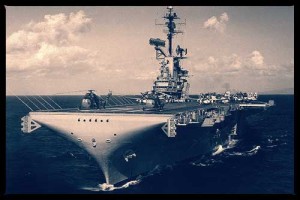 USS Yorktown (CV10) was the second ESSEX – class aircraft carrier and the fourth ship in the Navy to bear the name Yorktown. Originally named Bon Homme Richard, the carrier was renamed as the Yorktown on September 26, 1942, to honor CV 5 which was lost three months earlier during the Battle of Midway. Like her namesake, the ship was christened by by First Lady Eleanor Roosevelt. Yorktown was reclassified as attack aircraft carrier CVA 10 on October 1, 1952, and antisubmarine warfare aircraft carrier CVS 10 on September 1, 1957.
USS Yorktown (CV10) was the second ESSEX – class aircraft carrier and the fourth ship in the Navy to bear the name Yorktown. Originally named Bon Homme Richard, the carrier was renamed as the Yorktown on September 26, 1942, to honor CV 5 which was lost three months earlier during the Battle of Midway. Like her namesake, the ship was christened by by First Lady Eleanor Roosevelt. Yorktown was reclassified as attack aircraft carrier CVA 10 on October 1, 1952, and antisubmarine warfare aircraft carrier CVS 10 on September 1, 1957.
Decommissioned on June 27, 1970 at Philadelphia, Pa., the YORKTOWN was subsequently berthed with the Philadelphia Group, Atlantic Reserve Fleet. She remained there almost three years before her name was struck from the Navy list on June 1, 1973. During 1974, the Navy Department approved the donation of Yorktown to the Patriot’s Point Development Authority, Charleston, S.C. She was towed from Bayonne, N.J., to Charleston S.C., in June of 1975. She was formally dedicated as a memorial on the 200th anniversary of the Navy, October 13, 1975. Click here for a Photo Tour of the USS Yorktown at Mount Pleasant, SC.
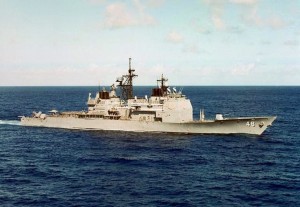 The fifth USS Yorktown was launched 17 January 1983 and commissioned on 4 July 1984 at Yorktown, Virginia, and was designed to take advantage of the American Aegis technology. Among its various weapon systems were surface to air missiles (SAMs), anti-ship/anti-submarine missiles, torpedo launchers, and a mounted cannon. Yorktown’s first deployment was from August 1985 to April 1986 and, among other things, involved the Achille Lauro hijacker intercept, two Black Sea excursions (in 1986 and 1988), and a trio of operations off the Libyan coast including Operation El Dorado Canyon and Operation Attain Document and Prairie Fire. Yorktown was decommissioned and struck on 10 December 2004.
The fifth USS Yorktown was launched 17 January 1983 and commissioned on 4 July 1984 at Yorktown, Virginia, and was designed to take advantage of the American Aegis technology. Among its various weapon systems were surface to air missiles (SAMs), anti-ship/anti-submarine missiles, torpedo launchers, and a mounted cannon. Yorktown’s first deployment was from August 1985 to April 1986 and, among other things, involved the Achille Lauro hijacker intercept, two Black Sea excursions (in 1986 and 1988), and a trio of operations off the Libyan coast including Operation El Dorado Canyon and Operation Attain Document and Prairie Fire. Yorktown was decommissioned and struck on 10 December 2004.
